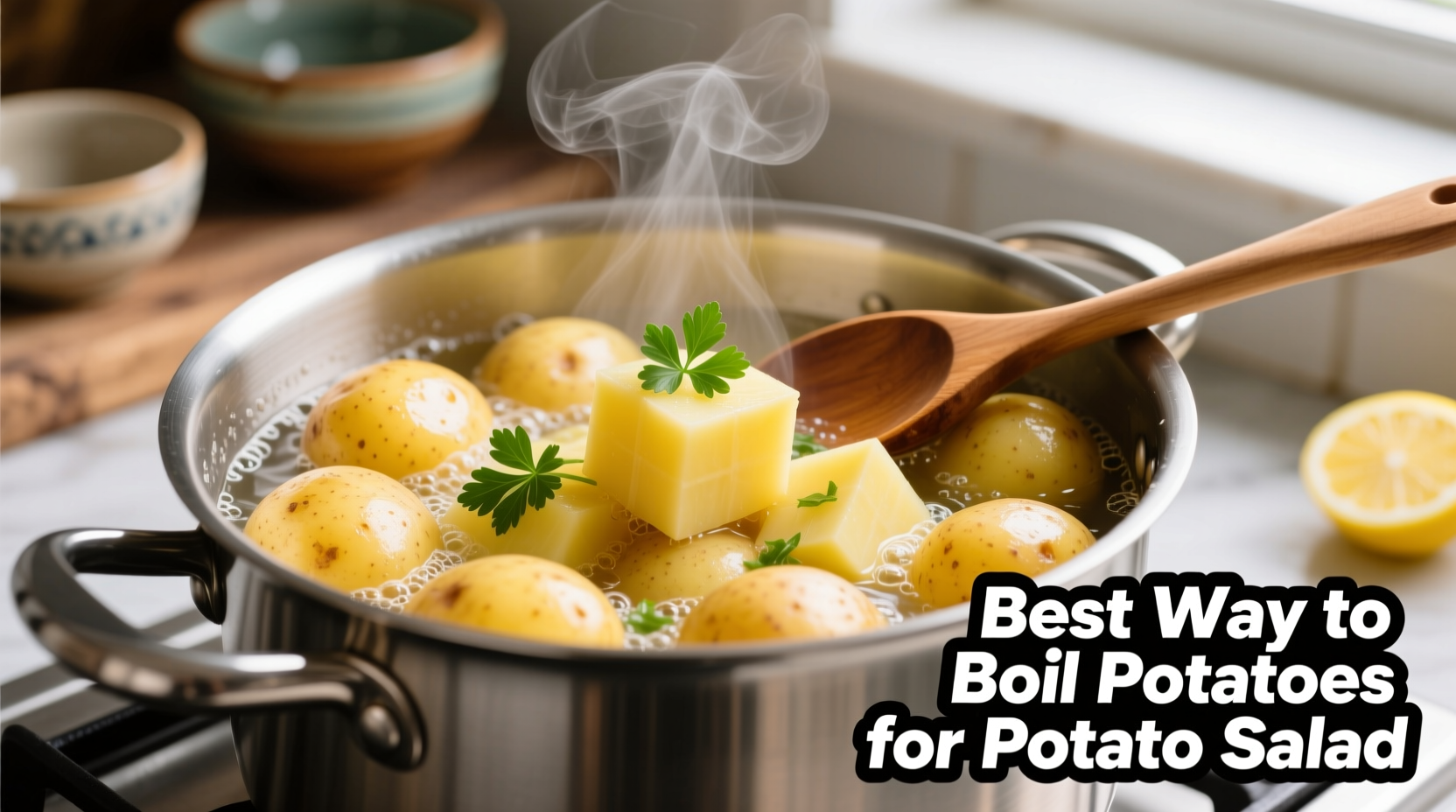Getting perfectly boiled potatoes for potato salad separates a mushy disaster from a creamy, cohesive dish that holds its shape. As a chef who's prepared thousands of potato salads across professional kitchens and home cooking demonstrations, I've discovered that the boiling technique makes all the difference. Skip the common mistakes of starting with hot water or overcooking, and you'll achieve that ideal firm-yet-creamy texture every time.
Why Proper Potato Boiling Matters for Salad
Potato salad demands potatoes that maintain their structure while absorbing dressing flavors. When potatoes become waterlogged or overcooked during boiling, they disintegrate when mixed with other ingredients. The right boiling technique creates potatoes with:
- Firm texture that holds shape when mixed
- Absorbent surface for dressing without becoming soggy
- Consistent cooking throughout (no hard centers)
- Perfect mouthfeel that complements other salad ingredients
Selecting the Right Potatoes
Not all potatoes work equally well for potato salad. Waxy varieties maintain their shape better than starchy potatoes, which tend to break down. Here's how common potato types perform:
| Potato Variety | Texture After Boiling | Best For Potato Salad? | Why It Works (or Doesn't) |
|---|---|---|---|
| Yukon Gold | Firm yet creamy | ✓ Excellent | Natural buttery flavor with perfect balance of waxiness and starch |
| Red Potatoes | Firm with thin skin | ✓ Excellent | Waxy texture holds shape well; skin adds visual appeal |
| Russet | Falls apart easily | ✗ Poor | Too starchy; becomes mushy when boiled for salad |
| Fingerling | Firm with distinctive shape | ✓ Good | Unique appearance but can be uneven in size |
| White Potatoes | Moderately firm | △ Acceptable | Works when Yukon Gold isn't available but less flavorful |
Step-by-Step Boiling Technique
Preparation: Setting Up for Success
Proper preparation prevents common potato salad failures. Follow these steps before heating water:
- Wash thoroughly - Scrub potatoes under cold running water to remove dirt (keep skins on for structure)
- Cut uniformly - Cut into 3/4-inch cubes for even cooking (larger pieces for German-style salad)
- Soak briefly - Rinse cut potatoes in cold water to remove excess starch that causes mushiness
- Use adequate pot size - Choose a pot where potatoes sit in a single layer with room to move
The Perfect Boiling Process
This technique prevents the two most common potato salad problems: waterlogged potatoes and inconsistent cooking.
- Start with cold water - Place potatoes in pot and cover with cold water (1 inch above potatoes)
- Add salt properly - Use 1½ tablespoons kosher salt per quart of water (seasons from within)
- Bring to gentle simmer - Heat over medium-high until bubbles form around edges (180-190°F)
- Maintain gentle simmer - Reduce heat to maintain small bubbles (avoid rolling boil)
- Time precisely - Cook 15-20 minutes until fork-tender but still holding shape
- Test frequently - Check at 12 minutes; potatoes should offer slight resistance
This cold-start method ensures even cooking from edge to center. Starting potatoes in hot water creates a temperature shock that cooks exteriors too quickly while centers remain hard.
Cooling: The Critical Step Many Skip
How you cool potatoes determines whether they stay firm or become waterlogged:
- Drain immediately - Don't let potatoes sit in hot water after cooking
- Ice bath is essential - Transfer to large bowl of ice water for 5-7 minutes
- Dry thoroughly - Spread on clean kitchen towel; pat dry before mixing
- Refrigerate uncovered - Chill 30 minutes before dressing to prevent mushiness
Skipping the ice bath causes residual heat to continue cooking potatoes, resulting in that dreaded mushy texture. Proper cooling stops the cooking process instantly while maintaining firm structure.

Avoid These Common Boiling Mistakes
Even experienced cooks make these errors that ruin potato salad texture:
- Overcrowding the pot - Too many potatoes lowers water temperature, causing uneven cooking
- Boiling too vigorously - Aggressive boiling breaks down potato structure
- Adding vinegar to water - Creates overly firm texture that doesn't absorb dressing well
- Peeling before boiling - Removes protective skin layer, causing water absorption
- Mixing while hot - Warm potatoes absorb too much dressing and become soggy
When This Method Doesn't Apply
While this boiling technique works for most potato salads, certain regional variations require adjustments:
- German potato salad - Potatoes are often served warm with vinegar-based dressing
- Southwestern style - Larger potato chunks hold up better with robust ingredients
- Make-ahead salads - Slightly undercook potatoes if dressing immediately
- High-altitude cooking - Increase cooking time by 25% as water boils at lower temperature
Understanding these context boundaries prevents recipe failures when adapting to different potato salad styles or environmental conditions.
Professional Chef's Secret Tips
From years of perfecting potato salad in professional kitchens, here are techniques that elevate your results:
- Add a bay leaf to boiling water for subtle aromatic complexity
- Use potato water to thin dressing slightly for better adhesion
- Cut potatoes while slightly warm for clean edges that hold dressing
- Season dressing while potatoes are still warm (but not hot) for maximum flavor absorption
- Let dressed salad rest 2 hours before serving for optimal flavor integration
Remember that the best way to boil potatoes for potato salad balances science and technique. The cold-start method with precise timing and proper cooling creates that perfect texture where potatoes maintain their shape while still absorbing dressing flavors. Following these professional techniques transforms a simple side dish into a standout component of any meal.











 浙公网安备
33010002000092号
浙公网安备
33010002000092号 浙B2-20120091-4
浙B2-20120091-4